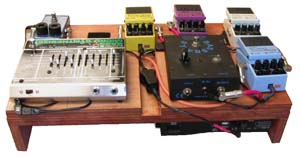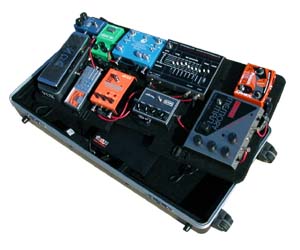
Guitar pedalboard
Encyclopedia
A guitar pedalboard is a flat board or panel which serves as a container, patch bay and power supply for effects pedals
for the electric guitar
. Some pedalboards contain their own transformer and power cables, in order to power a number of different pedals. Pedalboards assist the player in managing multiple pedals. The entire pedalboard can be packed up and transported to the next location without the need for disassembly.
Pedalboards often have a cover which protects the effects pedals during transportation. There are many varieties of pedalboard cases, including homemade DIY pedalboard cases, store-bought pedalboard cases, and, for professional musicians, custom-made pedalboard cases. Hard shell pedalboard-cases have foam padding, reinforced corners, and locking latches which protect the pedals during transport; during onstage performance, with the lid removed, the bottom of the case is a pedalboard. Most pedalboards have a flat surface where pedals and their power supplies are attached using Velcro or other techniques, and they often have a removable lid or padding to protect the pedals when they are not being used. Some pedalboards have handles or wheels to facilitate transportation.

DC power can be generated by batteries, an AC/DC power supply, or a rechargeable battery
. Each has its own advantages and disadvantages. Using individual batteries is fine for occasional players, because they don't have to worry about the cost of replacement batteries or changes in sound as batteries get tired. A battery typically lasts around two hours. Professional players normally replace all batteries with new ones before a show. A complete rechargeable solution can be found using the Pedal Jeanie peadalboard as it has the DC power and rechargeable batteries built in.
Using a DC power supply is a good alternative, even though the initial cost is higher. However, one has to pay attention to ground loops
and power line hum
. Noise gate
s can help to reduce the noise by suppressing the signal below a certain volume threshold, but this only controls unwanted noise without actually removing it from the signal.
 The third approach is to use a powerful rechargeable battery to drive all the pedals, and a battery charger to recharge the battery. This eliminates ground loops because the pedals are grounded at a single point: the amplifier. There are batteries on the market that can power over 20 effects pedals for eight hours on a single charge. The effects pedals are connected to the rechargeable battery via isolated DC-DC converters, which produce the required voltages.
The third approach is to use a powerful rechargeable battery to drive all the pedals, and a battery charger to recharge the battery. This eliminates ground loops because the pedals are grounded at a single point: the amplifier. There are batteries on the market that can power over 20 effects pedals for eight hours on a single charge. The effects pedals are connected to the rechargeable battery via isolated DC-DC converters, which produce the required voltages.
Using a rechargeable effects pedal battery or AC/DC power supply in conjunction with a “pedalboard suitcase” reduces setup time prior to a show.
Effects unit
Effects units are electronic devices that alter how a musical instrument or other audio source sounds. Some effects subtly "color" a sound, while others transform it dramatically. Effects are used during live performances or in the studio, typically with electric guitar, keyboard and bass...
for the electric guitar
Electric guitar
An electric guitar is a guitar that uses the principle of direct electromagnetic induction to convert vibrations of its metal strings into electric audio signals. The signal generated by an electric guitar is too weak to drive a loudspeaker, so it is amplified before sending it to a loudspeaker...
. Some pedalboards contain their own transformer and power cables, in order to power a number of different pedals. Pedalboards assist the player in managing multiple pedals. The entire pedalboard can be packed up and transported to the next location without the need for disassembly.
Pedalboards often have a cover which protects the effects pedals during transportation. There are many varieties of pedalboard cases, including homemade DIY pedalboard cases, store-bought pedalboard cases, and, for professional musicians, custom-made pedalboard cases. Hard shell pedalboard-cases have foam padding, reinforced corners, and locking latches which protect the pedals during transport; during onstage performance, with the lid removed, the bottom of the case is a pedalboard. Most pedalboards have a flat surface where pedals and their power supplies are attached using Velcro or other techniques, and they often have a removable lid or padding to protect the pedals when they are not being used. Some pedalboards have handles or wheels to facilitate transportation.

Pedal power supply
Most effects pedals are powered by varying levels of DC voltage, depending on the manufacturer. Possible voltages include 9V, 12V, 15V, 18V, 24V, and 40V, though 9V is most common. Some effects pedals accept a range of voltages, producing different effects. Guitar players can experiment with varying voltages to generate different sounds.DC power can be generated by batteries, an AC/DC power supply, or a rechargeable battery
Rechargeable battery
A rechargeable battery or storage battery is a group of one or more electrochemical cells. They are known as secondary cells because their electrochemical reactions are electrically reversible. Rechargeable batteries come in many different shapes and sizes, ranging anything from a button cell to...
. Each has its own advantages and disadvantages. Using individual batteries is fine for occasional players, because they don't have to worry about the cost of replacement batteries or changes in sound as batteries get tired. A battery typically lasts around two hours. Professional players normally replace all batteries with new ones before a show. A complete rechargeable solution can be found using the Pedal Jeanie peadalboard as it has the DC power and rechargeable batteries built in.
Using a DC power supply is a good alternative, even though the initial cost is higher. However, one has to pay attention to ground loops
Ground loop (electricity)
In an electrical system, a ground loop usually refers to a current, almost always unwanted, in a conductor connecting two points that are supposed to be at the same potential, often ground, but are actually at different potentials. Ground loops created by improperly designed or improperly installed...
and power line hum
Mains hum
Mains hum, electric hum, or power line hum is an audible oscillation of alternating current at the frequency of the mains electricity, which is usually 50 Hz or 60 Hz, depending on the local power line frequency...
. Noise gate
Noise gate
A Noise Gate or gate is an electronic device or software that is used to control the volume of an audio signal. In its most simple form, a noise gate allows a signal to pass through only when it is above a set threshold: the gate is 'open'. If the signal falls below the threshold no signal is...
s can help to reduce the noise by suppressing the signal below a certain volume threshold, but this only controls unwanted noise without actually removing it from the signal.

Using a rechargeable effects pedal battery or AC/DC power supply in conjunction with a “pedalboard suitcase” reduces setup time prior to a show.
See also
- Pete CornishPete CornishPete Cornish is a British designer of electric guitar effects and other electronic musical instruments. He is mainly noted for his elaborate fully custom guitar pedalboard systems...
- Effects unitEffects unitEffects units are electronic devices that alter how a musical instrument or other audio source sounds. Some effects subtly "color" a sound, while others transform it dramatically. Effects are used during live performances or in the studio, typically with electric guitar, keyboard and bass...
- Guitar amplifierGuitar amplifierA guitar amplifier is an electronic amplifier designed to make the signal of an electric or acoustic guitar louder so that it will produce sound through a loudspeaker...
- Distortion (guitar)Distortion (guitar)Distortion effects create "warm", "dirty" and "fuzzy" sounds by compressing the peaks of a musical instrument's sound wave and adding overtones. The three principal types of distortion effects are overdrive, distortion and fuzz. Distortion effects are sometimes called “gain” effects, as distorted...
- Electric guitarElectric guitarAn electric guitar is a guitar that uses the principle of direct electromagnetic induction to convert vibrations of its metal strings into electric audio signals. The signal generated by an electric guitar is too weak to drive a loudspeaker, so it is amplified before sending it to a loudspeaker...
External links
- "Chairmen of the Boards". Guitar PlayerGuitar PlayerGuitar Player is a popular magazine for guitarists founded in 1967. It contains articles, interviews, reviews and lessons of an eclectic collection of artists, genres and products. It has been in print since the late 1960s and during the 1980s, under editor Tom Wheeler, the publication was...
. May 1, 2008.

